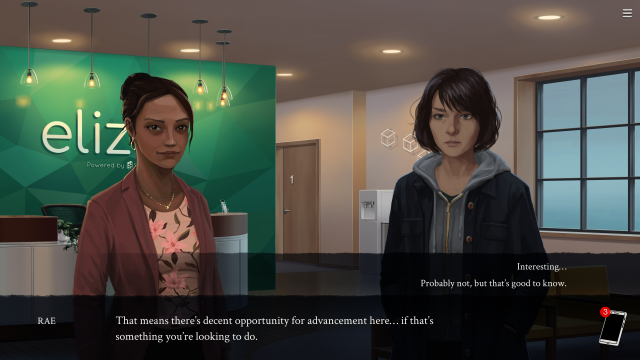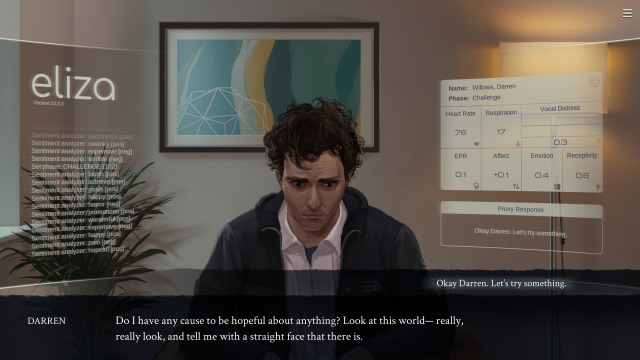Short Description of eliza:
eliza is a visual novel released by indie publisher Zachtronics in 2019. It is a game with a story to tell. One that is reminiscent of TV show “Black Mirror”. Set 20 minutes into the future, Evelyn works as a human stand-in (aka ‘proxy’) for the titular Artificial Intelligence ‘eliza’ to provide counselling services for clients who do not wish to go for psychiatric help. Players interact with different people in this world, listen to their stories and see what eliza is to different people.

Website link: http://www.zachtronics.com/eliza/
Analysis of Game:
The Lens of the Elemental Tetrad
Story
The story of eliza is one that is thought-provoking. Serving as a social commentary on the technocratic solutions to human problems such as mental wellness and moral dilemmas associated with it. It is also a story of the disenfranchised people who live in such a world with very relatable problems. Everyone you meet is fighting a battle most know nothing about, and as eliza, you listen.
Aesthetics:
eliza is a beautifully illustrated visual novel. It has a minimal but functional interface that is unobtrusive to the story. Each location is evocative of the atmosphere it desires, from the clean and futuristic Queen-Ann eliza counselling center to the hip sideview depiction of the coffeeshop the main character frequents. Combined with the music, each scene sets the tone for the events that follow. Even the Augmented Reality display eliza proxies wear with the technical analysis and client vitals conveys the feel of it being at the forefront of technology. A lot of care has also been put into the depiction of Evelyn’s phone which serve as a window to the happenings of her world, making it like a unique location unto itself.
Technology:
eliza is available on Steam for Windows, macOS, Linux and is also released on the Nintendo Switch. It does not require much hardware support which is nice to widen the access of audience to the story.
Mechanics:
Players follow Evelyn’s life and listen to dialog with other characters and get a glimpse into her world. Sometimes players are given choices to dialog and the ending is dependent on player choice. While no ending is ever locked due to player choice in the middle of the game, the ending which players feel most satisfied with depends on their choices earlier on.
Lens #73: The Lens of the Story Machine
eliza is a well crafted story. It follows a Strings of Pearls method, a mostly linear sequence of chapters that do not deviate much. However the player’s choices may open up different side interactions which lead back to the overarching narrative. While it may come across that player choice might not matter, the choices do generate different stories for the player as how they view their relationship with different character changes which may cause different choices to result in players perceiving different endings as the “true ending”.
Lens #01: The Lens of Emotion
As a proxy for eliza, the player is privy to the outpourings of several characters in the game. Most notably are those who have very relatable issues. A down on their luck artist, Maya for example, is a repeat customer the player sees often. Over the course of multiple sessions, you get to know her struggles against an apathetic art world stacked against her, how it feels like its not about art but a popularity contest and culminates in her wondering if she should let go of her long held dream. This is one of many stories the players would hear and their anguish is heart-rending to hear. In contrast even acting as the eliza proxy does takes it toll. It can be quite emotionally draining to listen to all the problems these characters may have. Sometimes it can be boring.
Lens #72: The Lens of Projection
In eliza, a good portion of the player’s interaction with the world is through Evelyn’s phone. With a streamlined user interface, players can read her mail, her chats and various other apps which all add to the world building and help the players feel like they are part of it. Much like how it is very natural to use a phone messaging application to talk to people rather than a talk in person, at times it feels as if using Evelyn’s phone to message people feels more like I am talking to the person than seeing them as a character on the screen. The game even lampshades this with an article detailing that while regular users of eliza speak to a human proxy for the human touch, the mental wellness programs targeted to aid students take the form of a chat application because that is what kids these days are more comfortable with.

Lens #80: The lens of Help
“I just want to help people.” As an eliza proxy, the players get to listen to the troubles of so many people. eliza was originally made to ensure everyone could have ready access to some mental counselling. Not everyone has a support network of friends, not everyone has the financial capacity for psychiatrict help or knows they can. In this story, it goes two fold, Evelyn as an eliza proxy could choose to follow the script eliza gives her or deviate and provide what she thinks is the right counsel to customers. As a top computer scientist, Evelyn could choose to work to advance the eliza AI to potentially help many people at once, or take the other path to help people one at a time. The game portrays that there is no clear answer to any of these questions and supports all decisions the players choose.
